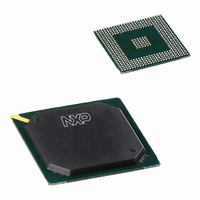PNX1500E/G,557 NXP Semiconductors, PNX1500E/G,557 Datasheet - Page 127

PNX1500E/G,557
Manufacturer Part Number
PNX1500E/G,557
Description
IC MEDIA PROC 240MHZ 456-BGA
Manufacturer
NXP Semiconductors
Specifications of PNX1500E/G,557
Applications
Multimedia
Core Processor
TriMedia
Controller Series
Nexperia
Interface
I²C, 2-Wire Serial
Number Of I /o
61
Voltage - Supply
1.14 V ~ 1.26 V
Operating Temperature
0°C ~ 85°C
Mounting Type
Surface Mount
Package / Case
456-BGA
Lead Free Status / RoHS Status
Lead free / RoHS Compliant
Program Memory Type
-
Ram Size
-
Lead Free Status / Rohs Status
Compliant
Other names
568-1296
935277746557
PNX1500E/G
935277746557
PNX1500E/G
- Current page: 127 of 828
- Download datasheet (8Mb)
Philips Semiconductors
Volume 1 of 1
Table 8: Global Registers
PNX15XX_SER_3
Product data sheet
Input and Output Control Registers
Offset 0x06 3000
31:8
7
6:5
Bit
Symbol
Unused
VDI_MODE_7
Unused
VDI_MODE
Acces
s
-
R/W
-
Value
-
0
-
Rev. 3 — 17 March 2006
Description
To ensure software backward compatibility, writes to unused or
reserved bits should be zero and reads must be ignored.
This bit should be set to ‘1’ only when FGPI is set to work in 8-bit
mode.
This bit controls dedicated hardware located in the input router that
allows to use the FGPI module as a second module to capture a
656 video source. However in this mode there is no on-the-fly video
image processing possible and the YUV data is linearly stored in
memory (VIP uses YUV planes). The dedicated hardware allows to
generate fgpi_start and fgpi_stop signals that directs FGPI to store
each field of the in-coming 656 video stream into a separate buffer.
The description bellow explains the behavior of the state machine
for that dedicated pattern matching hardware.
0: Disable pattern matching state machine for FGPI start/stop
signals.
1: Enable pattern matching state machine for FGPI start/stop
signals.
When first enabled, the pattern matching state machine is in its
“INIT” state and begins comparing fgpi_data[7:0] for the pattern
0xFF, 0x00, 0x00, and 0xEC on each fgpi clock. Once this pattern is
detected, it enters the “MAIN” state.
Below are listed the patterns for fgpi_start and fgpi_stop signal
assertion/de-assertion when in the MAIN state. The fgpi_start
signal asserts for one fgpi clock when the fourth byte of the pattern
is matched. The fgpi_start signal de-asserts on the next fgpi clock
and remains de-asserted until one of the patterns is detected. The
fgpi_stop asserts when the assertion pattern is detected and
remains asserted until the de-assertion pattern is detected. The
pattern matching state machine returns to the “INIT” state when
VDI_MODE[7] = 0 or the FGPI block is reset with a Hardware or
Software reset.
fgpi_start = 1 when fgpi_data[7:0] =0xFF, 0x00, 0x00, 0x9D or
0xFF, 0x00, 0x00, 0xDA or
0xFF, 0x00, 0x00, 0xF1 or
0xFF, 0x00, 0x00, 0xB6
else fgpi_start = 0.
fgpi_stop = 1 when fgpi_data[7:0] =0xFF, 0x00, 0x00, 0xF1
fgpi_stop = 0 when fgpi_data[7:0] =0xFF, 0x00, 0x00, 0xB6
To ensure software backward compatibility, writes to unused or
reserved bits should be zero and reads must be ignored.
Chapter 3: System On Chip Resources
© Koninklijke Philips Electronics N.V. 2006. All rights reserved.
PNX15xx Series
3-18
Related parts for PNX1500E/G,557
Image
Part Number
Description
Manufacturer
Datasheet
Request
R

Part Number:
Description:
Manufacturer:
NXP Semiconductors
Datasheet:
Part Number:
Description:
Digital Signal Processors & Controllers - DSP, DSC NEXPERIA MEDIA PROC 240MHZ
Manufacturer:
NXP Semiconductors
Part Number:
Description:
Digital Signal Processors & Controllers - DSP, DSC PNX1500, 240MHZ
Manufacturer:
NXP Semiconductors
Part Number:
Description:
NXP Semiconductors designed the LPC2420/2460 microcontroller around a 16-bit/32-bitARM7TDMI-S CPU core with real-time debug interfaces that include both JTAG andembedded trace
Manufacturer:
NXP Semiconductors
Datasheet:

Part Number:
Description:
NXP Semiconductors designed the LPC2458 microcontroller around a 16-bit/32-bitARM7TDMI-S CPU core with real-time debug interfaces that include both JTAG andembedded trace
Manufacturer:
NXP Semiconductors
Datasheet:
Part Number:
Description:
NXP Semiconductors designed the LPC2468 microcontroller around a 16-bit/32-bitARM7TDMI-S CPU core with real-time debug interfaces that include both JTAG andembedded trace
Manufacturer:
NXP Semiconductors
Datasheet:
Part Number:
Description:
NXP Semiconductors designed the LPC2470 microcontroller, powered by theARM7TDMI-S core, to be a highly integrated microcontroller for a wide range ofapplications that require advanced communications and high quality graphic displays
Manufacturer:
NXP Semiconductors
Datasheet:
Part Number:
Description:
NXP Semiconductors designed the LPC2478 microcontroller, powered by theARM7TDMI-S core, to be a highly integrated microcontroller for a wide range ofapplications that require advanced communications and high quality graphic displays
Manufacturer:
NXP Semiconductors
Datasheet:
Part Number:
Description:
The Philips Semiconductors XA (eXtended Architecture) family of 16-bit single-chip microcontrollers is powerful enough to easily handle the requirements of high performance embedded applications, yet inexpensive enough to compete in the market for hi
Manufacturer:
NXP Semiconductors
Datasheet:

Part Number:
Description:
The Philips Semiconductors XA (eXtended Architecture) family of 16-bit single-chip microcontrollers is powerful enough to easily handle the requirements of high performance embedded applications, yet inexpensive enough to compete in the market for hi
Manufacturer:
NXP Semiconductors
Datasheet:
Part Number:
Description:
The XA-S3 device is a member of Philips Semiconductors? XA(eXtended Architecture) family of high performance 16-bitsingle-chip microcontrollers
Manufacturer:
NXP Semiconductors
Datasheet:

Part Number:
Description:
The NXP BlueStreak LH75401/LH75411 family consists of two low-cost 16/32-bit System-on-Chip (SoC) devices
Manufacturer:
NXP Semiconductors
Datasheet:

Part Number:
Description:
The NXP LPC3130/3131 combine an 180 MHz ARM926EJ-S CPU core, high-speed USB2
Manufacturer:
NXP Semiconductors
Datasheet:

Part Number:
Description:
The NXP LPC3141 combine a 270 MHz ARM926EJ-S CPU core, High-speed USB 2
Manufacturer:
NXP Semiconductors

Part Number:
Description:
The NXP LPC3143 combine a 270 MHz ARM926EJ-S CPU core, High-speed USB 2
Manufacturer:
NXP Semiconductors










